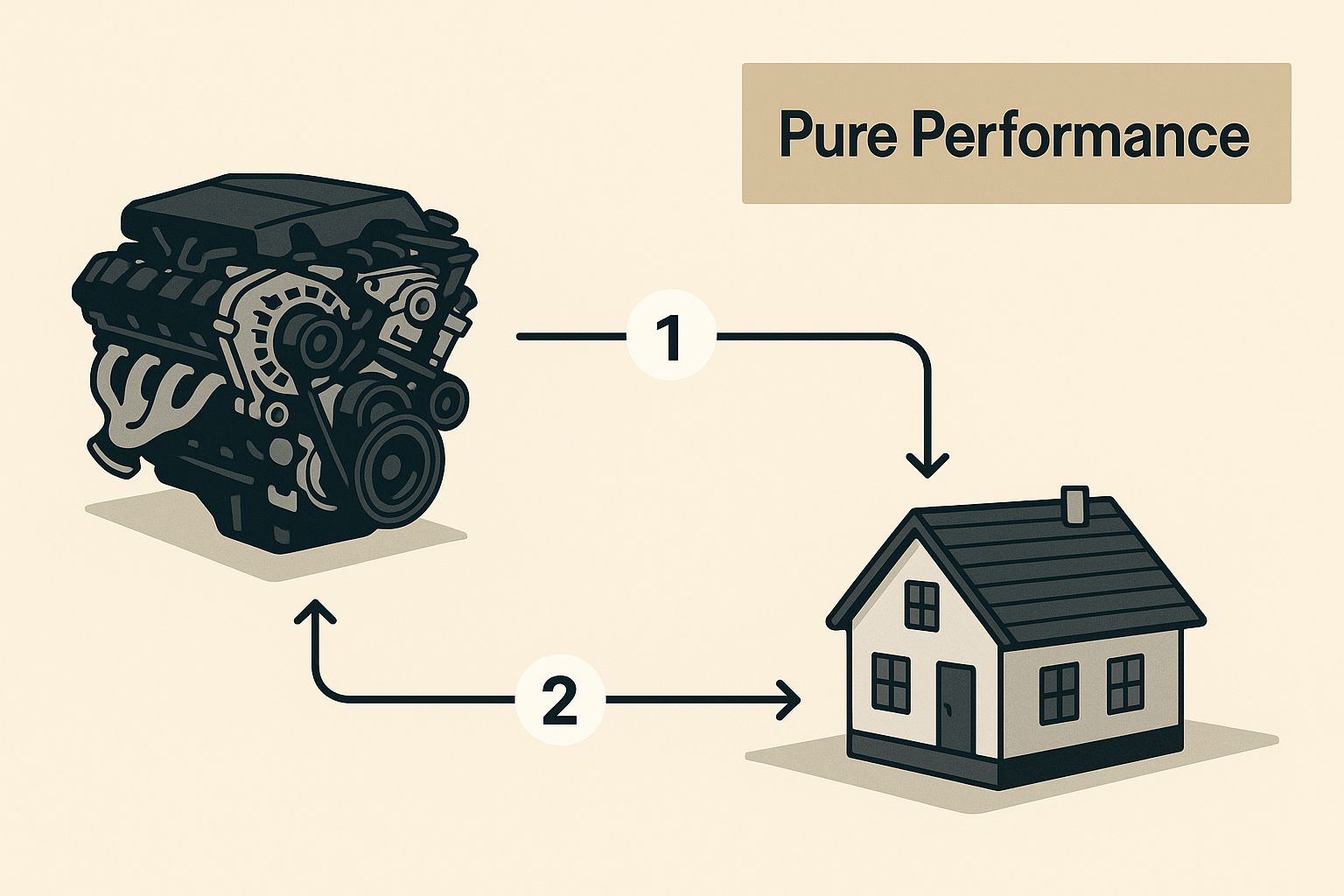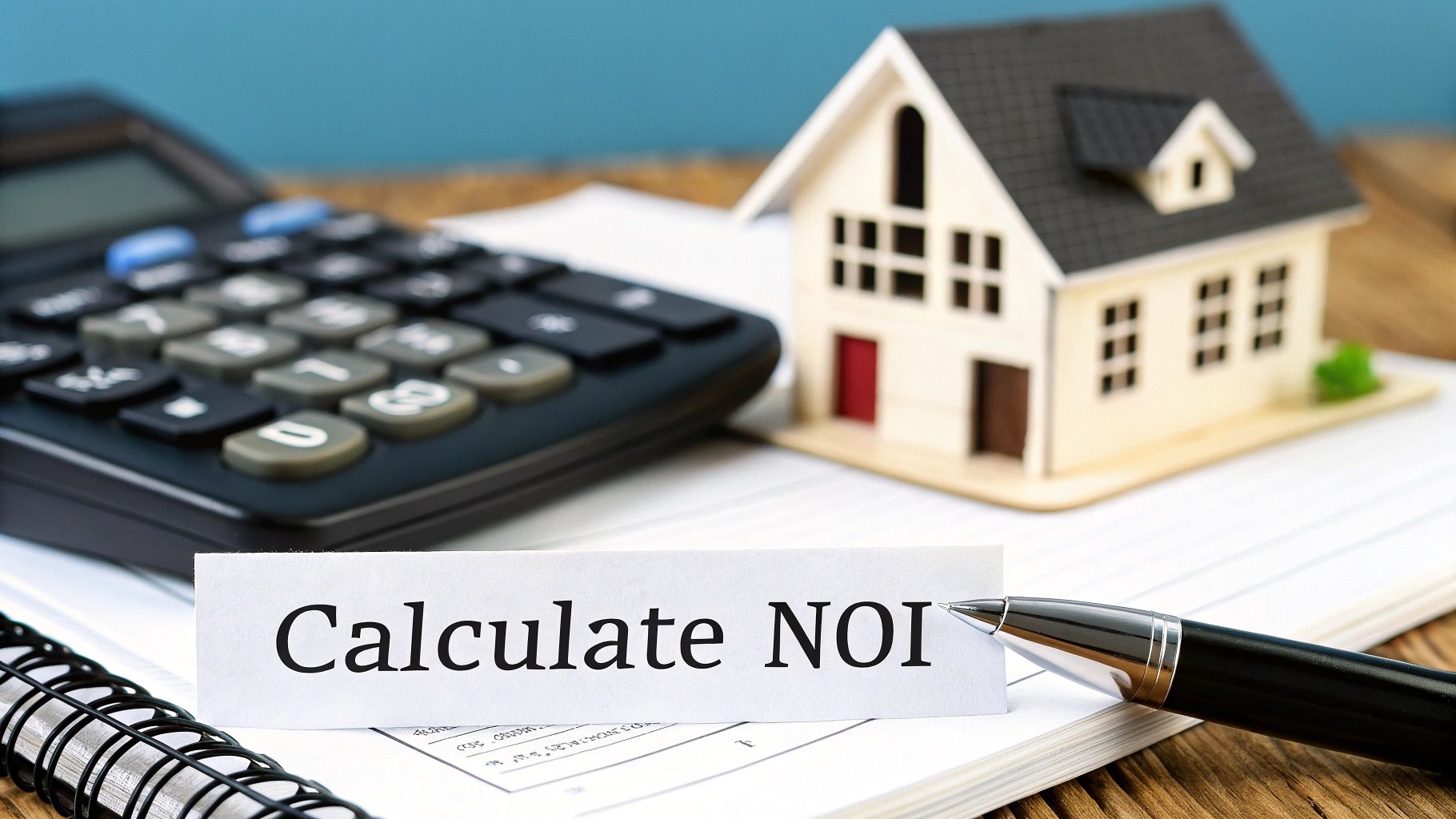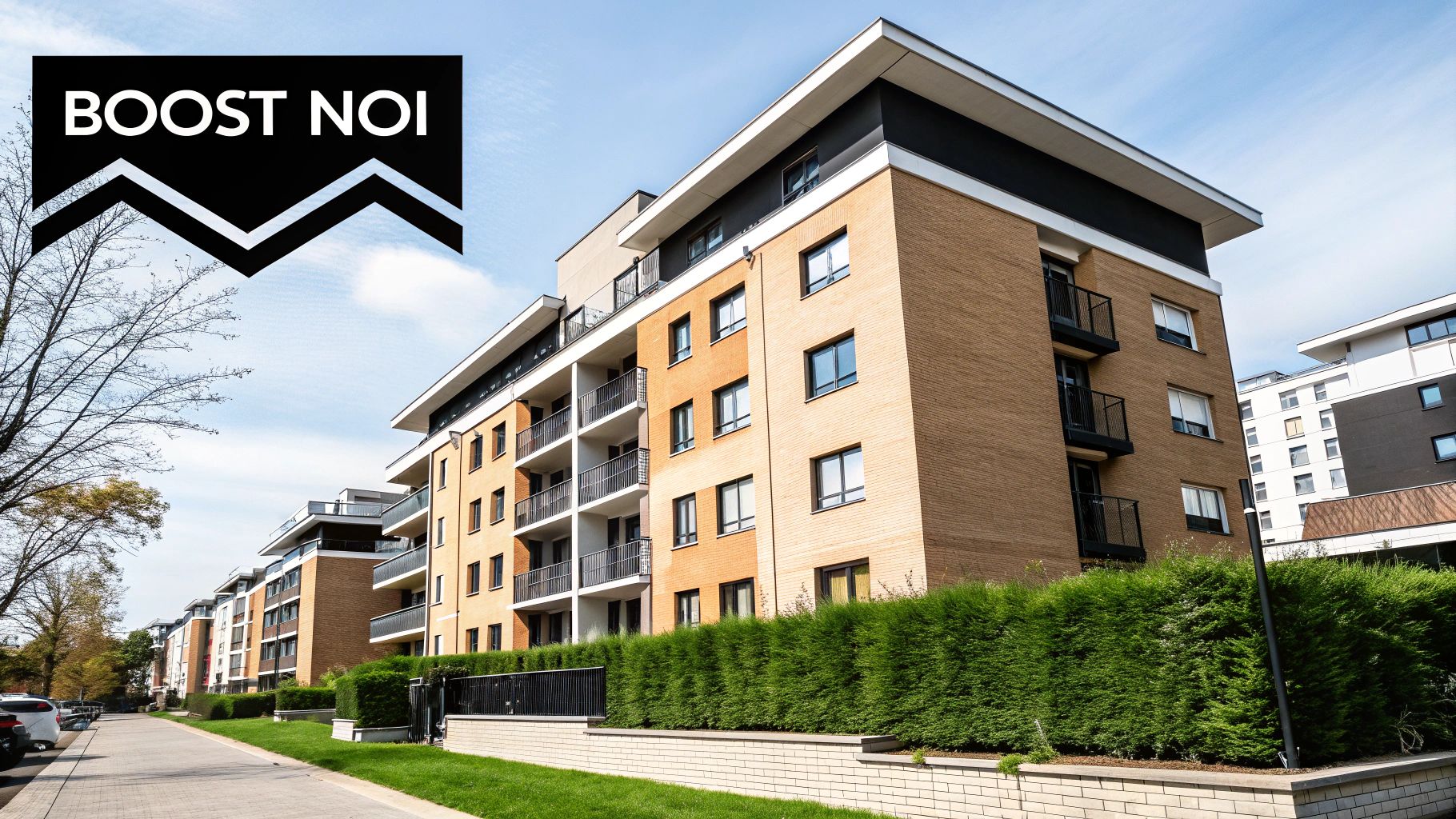If you're looking at a real estate investment, its Net Operating Income (NOI) is the single most important number you need to understand. Think of it as the property's financial pulse—it tells you exactly how much profit the asset generates on its own, before you even consider mortgage payments or income taxes.
NOI cuts through the noise. It isolates the pure, unadulterated performance of the property itself, separate from the owner's personal financing choices or tax situation.
So, What Is NOI and Why Should You Care?
Imagine you're evaluating a classic car. You'd want to know how powerful its engine is, right? That engine's performance is a core measure of the car's value, regardless of who is driving it or how they financed the purchase. A property's NOI is just like that engine's horsepower.
A high NOI signals a healthy, profitable property that's attractive to potential buyers, investors, and lenders. It’s the foundational metric that allows you to make smart, confident decisions about whether an investment is worth pursuing.
This infographic breaks down how NOI zeroes in on the property's operational health, separating it from external financial factors.

The formula is straightforward: you take all the income a property generates and subtract all the necessary operating expenses.
For a quick reference, here's a simple breakdown of what goes into the NOI calculation.
Quick Guide to Understanding NOI
| Component | Description |
|---|---|
| Gross Income | All revenue generated by the property, including rent, parking fees, and laundry income. |
| Operating Expenses | The day-to-day costs to run the property, such as insurance, property taxes, maintenance, and management. |
| Exclusions | Costs that are not included, like mortgage payments, depreciation, and income taxes. |
| The Result (NOI) | The property's pure, unleveraged profit—a direct measure of its operational efficiency. |
This table highlights the core elements, showing how NOI provides a clear, standardized view of a property's financial performance.
Let's put it into practice. If a building brings in $100,000 in gross income and has $40,000 in operating expenses, its NOI is $60,000. It’s that simple. This number is your starting point for nearly every other calculation, from property valuation to determining cash flow.
Mastering how to manage the income and expenses that make up your NOI is the key to a successful investment. Today, many investors rely on modern tools to help them, and you can learn more about the growing role of technology in property management in our detailed guide.
How to Calculate Net Operating Income Step by Step
Knowing the definition of Net Operating Income is one thing, but being able to calculate it yourself is where the real confidence comes from. The formula is actually quite straightforward, but the trick is knowing exactly which numbers to plug in and which to leave out.

At its heart, the calculation is simple:
Net Operating Income (NOI) = Gross Operating Income (GOI) – Operating Expenses (OpEx)
Think of it like running a coffee shop. The GOI is all the money you collect from selling coffee, pastries, and merchandise. The OpEx is the cost of your beans, milk, electricity, and paying your baristas. What’s left over before you pay your business loan is your NOI—the true measure of the shop's profitability.
Let's unpack each part of that formula.
Step 1: Identify Gross Operating Income
First, you need to tally up all the money the property actually brings in. This is its Gross Operating Income (GOI), and it’s often more than just the rent.
You'll want to include every income stream, such as:
- Rental Income: The main event, of course.
- Parking Fees: Money from dedicated spots or visitor parking.
- Laundry Facilities: The quarters or card swipes from on-site machines really add up.
- Vending Machines: Revenue from any snack or soda dispensers.
- Amenity Fees: Extra charges for things like pet fees or access to storage units.
Adding all these together gives you the property’s total earning potential before a single bill gets paid.
Step 2: Subtract Operating Expenses
Next, you subtract the day-to-day costs of keeping the lights on and the property in good shape. These are your Operating Expenses (OpEx). Getting this part right is critical.
What to Include in OpEx:
- Property Taxes: Your annual bill from the local government.
- Insurance: The cost to protect your asset.
- Utilities: Any water, gas, or electricity for common areas that you pay for, not the tenants.
- Repairs & Maintenance: The budget for routine landscaping, plumbing fixes, and general upkeep.
- Property Management Fees: What you pay a professional to handle the daily grind.
When you're totaling up your OpEx, remember to account for all eligible costs. Many of these, like rental property tax deductions, can have a significant impact on your final numbers.
What NOT to Include in OpEx:
This is where many investors get tripped up. The following are not operating expenses:
- Mortgage Payments (Debt Service): This is a financing cost, not an operational one. NOI shows the property's performance independent of your loan.
- Capital Expenditures (CapEx): Big-ticket, one-off upgrades like a new roof or a boiler replacement. These aren't routine expenses.
- Income Taxes: These are specific to the owner's financial situation, not the property itself.
- Depreciation: This is a non-cash expense used for tax purposes, an "on-paper" deduction.
Confusing a major capital expense with a routine operating expense is an easy mistake that can throw off your NOI and make a property look less profitable than it truly is.
If you want to see this in action with more detailed examples, our guide on https://clouddle.com/blog/how-to-find-net-operating-income/ breaks it down even further.
Using NOI to Make Smarter Investment Decisions
Figuring out a property's Net Operating Income is just the first step. The real magic happens when you use that number to shape your investment strategy. Think of NOI as the great equalizer; it allows you to compare the raw profitability of different properties without getting bogged down by financing terms or an owner's unique tax situation.
This lets you make a true apples-to-apples comparison, focusing purely on which property is a better-run business.
A property’s NOI is also directly tied to its market value through a key metric called the Capitalization Rate (or Cap Rate). The relationship is straightforward: Property Value = NOI / Cap Rate. So, a higher, healthier NOI doesn't just mean more cash in your pocket each month—it means you're sitting on a more valuable asset.
Why Lenders Focus on NOI
So, what does NOI mean in real estate to a lender? Everything. It's the purest measure of a property's ability to generate cash and pay its bills. Lenders look at the NOI to see if the property can comfortably cover the mortgage payments long before they ever look at an owner's personal finances.
For example, a property pulling in an NOI of $100,000 is a far safer bet than one generating just $30,000, even if they're selling for the same price. That higher NOI provides a much bigger safety net for covering debt and handling surprises.
We saw this play out dramatically during the COVID-19 pandemic. When commercial tenants couldn't pay rent, rental income plummeted, crushing the NOI for countless properties. This tanked their valuations and made it nearly impossible for owners to refinance or get new loans. You can read more about how economic shifts impact commercial real estate NOI on Caliberco.com.
At the end of the day, a weak NOI is a huge red flag for both investors and lenders. On the flip side, a strong, consistent NOI is the bedrock of a great deal, opening the door to better financing and a more secure investment. For investors looking to layer technology onto this fundamental analysis, tools like Automated Valuation Models for Real Estate can offer another perspective on a property's value.
Proven Strategies to Increase Your Property's NOI
A higher Net Operating Income isn't just some abstract figure on a spreadsheet. Think of it as the engine that drives your property's value and profitability. To get more power out of that engine, you really only have two levers to pull: crank up every dollar of revenue you can, and trim down your expenses wherever possible.

When you successfully increase your NOI, you're not just making more money month-to-month; you're fundamentally transforming your asset into a more powerful income-generating machine. Let’s look at how to tune this engine for peak performance.
Smart Ways to Maximize Revenue
Growing your income is about much more than just bumping up the rent every year. The sharpest investors are always on the lookout for other revenue streams that add real value for tenants while also padding the bottom line.
Here are a few powerful ideas to get you started:
- Introduce Premium Services: Think about what your tenants would gladly pay extra for. This could be anything from dedicated premium parking spots and on-site storage units to secure package locker services.
- Optimize Existing Spaces: That underused common area? It could be a co-working space, a small gym, or a reservable event room. You can create brand-new income from square footage you already have.
- Focus on Occupancy: A vacant unit is a huge financial drain. Keeping occupancy high through excellent service and proactive management is one of the most effective ways to protect your income. For more ideas, check out our guide on effective tenant retention strategies.
Effective Strategies for Minimizing Expenses
On the flip side of the NOI coin is expense control. The goal here isn't just to slash costs indiscriminately. It’s about spending smarter without compromising the quality that keeps your tenants happy and willing to pay good money to live there.
A classic mistake is gutting the maintenance budget to save a few bucks. This almost always backfires, leading to bigger, more expensive repairs down the road and frustrated residents. The real win is finding efficiencies that don't hurt the tenant experience.
A great place to start is with a thorough energy audit to pinpoint waste. You can also try renegotiating contracts with your regular vendors—everything from landscaping to trash removal is on the table.
Adopting modern property technology can also lead to big savings. For instance, buildings with high-efficiency energy systems and smart home features are often more attractive to tenants and can command higher rents, which directly boosts your NOI.
To help you visualize this, here’s a breakdown of how you can tackle both sides of the NOI equation.
Boosting Your NOI: Revenue vs. Expense Strategies
| Strategy Type | Example Tactic | Potential Impact |
|---|---|---|
| Revenue Growth | Adding a paid pet-friendly amenity like a dog wash station. | Creates a new income stream and attracts a wider pool of high-value tenants. |
| Expense Reduction | Installing low-flow toilets and faucets across all units. | Significantly lowers monthly water and sewer bills with a one-time investment. |
| Revenue Growth | Partnering with a local laundry service for a revenue-share model. | Offers a convenient service for tenants while generating passive income for the property. |
| Expense Reduction | Auditing and appealing property tax assessments annually. | Can lead to substantial savings, directly increasing the cash available. |
By methodically working on both revenue generation and smart cost-cutting, you create a clear, actionable roadmap to a much healthier financial future for your property.
Common Mistakes to Avoid When Calculating NOI
Calculating Net Operating Income seems straightforward on the surface, but a few common slip-ups can completely throw off your numbers. Getting it wrong can make a great deal look terrible, or even worse, make a bad investment look like a winner.
Think of the NOI formula as a sensitive instrument. Even small errors can lead to big miscalculations, so it’s crucial to know the common pitfalls. Mastering what NOI means in real estate also means knowing how not to calculate it.
Mixing Up Capital Expenditures and Operating Expenses
This is, without a doubt, the most frequent mistake I see investors make. It’s easy to confuse Operating Expenses (OpEx)—the everyday costs like utilities, landscaping, and minor repairs—with Capital Expenditures (CapEx).
CapEx refers to major upgrades that extend the life of the property, like putting on a new roof or overhauling the HVAC system. These are not day-to-day costs.
If you lump a $20,000 roof replacement into your annual operating expenses, you’ll artificially tank your NOI for that year. It makes a perfectly healthy property look like it’s bleeding money. Remember: OpEx keeps the lights on; CapEx improves the building itself.
Failing to distinguish between the two gives you a distorted picture of how the property is actually performing on a routine basis.
Forgetting About Vacancy and Credit Losses
It's tempting to look at a rent roll and assume you'll collect 100% of the potential income, 100% of the time. But in the real world, that almost never happens.
Tenants move out, leaving units empty for a month or two. Sometimes, life happens, and a tenant simply can't pay. That's why smart investors always factor in a "vacancy and credit loss" line item, typically between 5-10% of the total potential rent.
Ignoring this reality gives you an inflated, overly optimistic NOI. It’s a classic rookie mistake that sets you up for a nasty surprise when the actual cash flow doesn't match your projections.
Including Debt Service in the Calculation
Finally, you have to keep your mortgage payment out of the NOI equation. Your loan, or debt service, is a financing expense, not an operating expense.
NOI is designed to measure the profitability of the property itself, completely independent of how you financed it. This allows you to compare an all-cash deal to a highly leveraged one on an apples-to-apples basis.
When you include debt service, you’re no longer calculating NOI; you’re calculating pre-tax cash flow. It muddies the water and defeats the purpose of using NOI as a universal yardstick for property performance.
Your Top NOI Questions, Answered
Even after you get the hang of NOI, a few specific questions always seem to come up. Getting these details straight is what separates a savvy analysis from a costly mistake.
Think of it this way: understanding the big picture is great, but knowing the nuances is what gives you a real edge. Let's clear up some of the most common points of confusion.
What Is the Difference Between NOI and Cash Flow?
This is probably the most important distinction to nail down. They sound similar, but they tell you two very different stories about an investment.
Net Operating Income (NOI) tells you how profitable the property itself is, completely ignoring any mortgage or financing. It's the pure, unvarnished performance of the asset. Cash flow, on the other hand, is the money you actually put in your pocket after paying the bank.
Here’s the breakdown:
- NOI judges the property.
- Cash Flow judges your deal structure on that property.
The simple math is: Cash Flow = NOI – Debt Service (your mortgage payment). You could have a property with a fantastic NOI that bleeds cash every month simply because it's carrying too much debt.
Can a Property Have a Negative NOI?
Yes, it absolutely can—and it’s a five-alarm fire for any investor.
A negative NOI means the property’s day-to-day operating expenses are higher than all the income it brings in. Forget about paying the mortgage or making a profit; the property can't even support itself.
A negative NOI means you have a fundamentally broken business model. It's like a corner store spending more on rent, electricity, and staff than it makes selling coffee and snacks. The core operation is losing money before you even think about loan payments.
Seeing a negative NOI means something needs to change, fast. You either have to find a way to dramatically increase revenue or take a hatchet to the expenses.
How Does NOI Relate to Property Taxes?
This is another common trip-up. The answer is simple but critical: property taxes are always included as an operating expense when you calculate NOI. They are a direct cost of owning and running the building.
What’s not included are the owner’s personal income taxes. NOI is completely agnostic to an investor's individual tax situation. It focuses solely on the property's financial health.
So, let's be crystal clear:
- Taxes tied to the property? Yes, you subtract those to get to NOI.
- Taxes tied to your personal profit? No, those stay out of the calculation.
At Clouddle Inc, we know that growing your NOI is the name of the game. Our managed technology solutions, from smart Wi-Fi to integrated security, are built to help you trim operating expenses while adding amenities that attract and retain tenants. See how our Network-as-a-Service model can boost your property’s bottom line by visiting https://www.clouddle.com.


